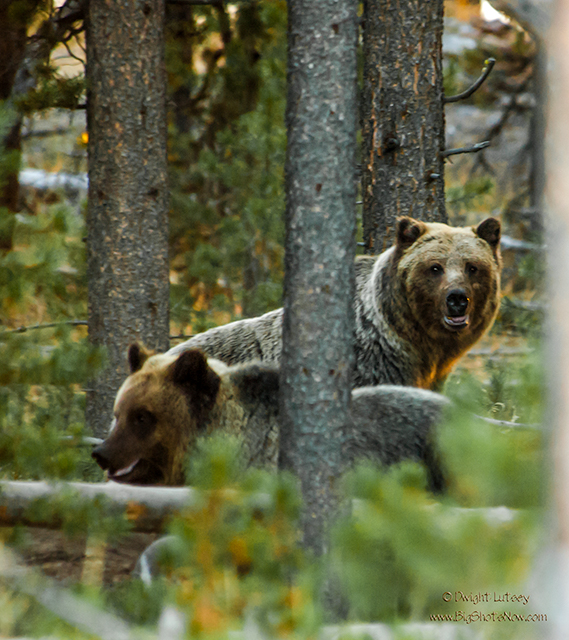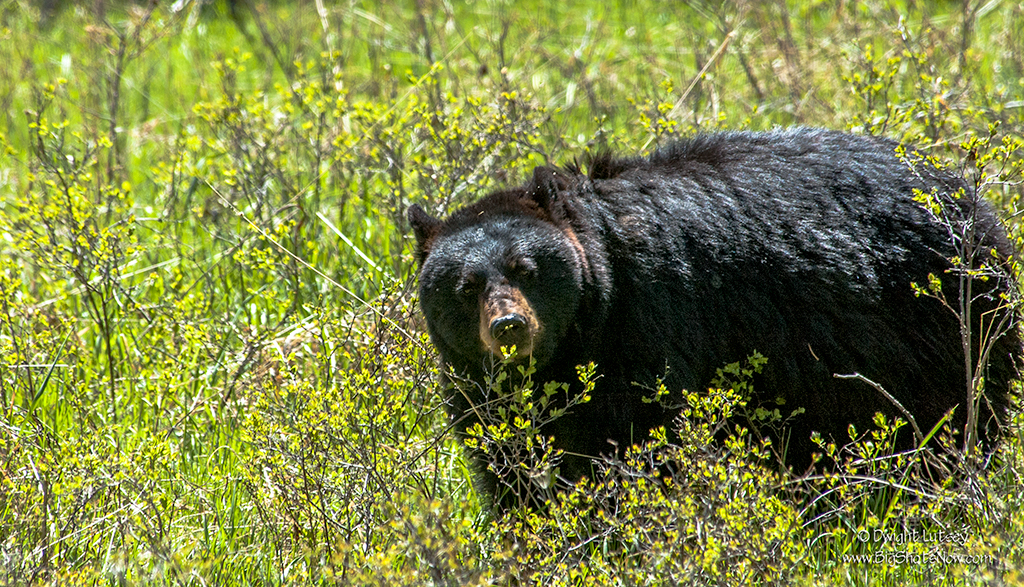Periodically we here at The Institute go out on the World Wide Web to check facts that are available to our readers regarding some of the wildlife they may be interested in. We are fact checkers. As you might imagine there is a lot of information out there, some of it good and some of it downright wrong. Or at least misinterpreted. We set our official fact gleaners to work gleaning and they visited some bear websites to check out those bear statements. This was done because we get so many cards and letters asking for fun-filled facts about bears.
Here are just a few of those facts that we found out there that need further explanation or correction to make them complete and more accurate or even believable.
First bears, and in this case grizzly bears, have been around for a long time. At least since 2005 when this picture was taken by our Director with one of the first legitimate digital cameras available. They may have been around longer than that but if so not many people knew about them because there weren’t any digital photos taken of them. This was back in the dawn of the digital age when 6 megapixels was considered to be the height of photographic technology. Many new species were being discovered then and documented using this new photographic tool, so we feel confident in correcting or adding information to the wealth of information about grizzly bears out there on the web.
Fact: A male bear is called a boar or a he-bear. A female bear is called a sow or a she-bear. A group of bears is called a sleuth or sloth. We can find no reason to dispute this fact although we have found that actually calling these bears he-bear, or she-bear to their faces makes them anxious and somewhat touchy, so we don’t recommend it. We have also called a group of them a sleuth and found that it made them all look at us appraisingly so we don’t recommend doing that either. Your results may vary.
Fact: Bears have been known to eat almost anything, including snowmobile seats, engine oil, and rubber boots. We can find no corroborating evidence to support this fact so we cannot endorse it. We can state however that a determined bear will eat the entire door off a motorhome if there are ding-dongs inside.
Fact: In a similar vein we heard that in 2008, a Canadian man was attacked by a grizzly bear. He survived the attack by playing dead, even when the bear began to gnaw on his scalp. The bear eventually lost interest and went away. The bear did take his watch, an undetermined amount of travelers checks and a can of bear spray however, plus his iPod but inexplicably not the ear buds. We believe this fact to be true as we have personally seen bears with iPods on several occasions.
Fact: During hibernation, a bear does not defecate. Its body can somehow recycle body waste into protein—a process scientists still do not understand. This is just so wrong that we can’t even address it. What kind of sick mind makes this stuff up.
Fact: The lips of bears are not attached to their gums, which make their lips look rubbery. This is true. It is also why they sound like Mick Jagger when they talk.
Fact: The most accurate way to determine the age of a bear is to count the rings in a cross-section of its tooth root under a microscope. We have found that this might be true but have been unable to substantiate it due to no one ever surviving the attempt to complete the procedure.
Fact: Bears are very smart and have been known to roll rocks into bear traps to set off the trap and eat the bait in safety. Yes this is true. What should be added however is that bears will often force tourists or other interested parties to carry the rocks for them under threat of doing them bodily harm if they don’t and then extorting them into bringing them more bait on a regular basis. Many unsuspecting people enter into bear territory completely unaware of the Bearsa Nostra and pay a huge price for their ignorance.
Fact: Bears are bowlegged. This gives them better grip and balance. Ummmm, on what? We believe this is bogus.
Fact: Grizzly bears use growls, roars and snorts to communicate with each other. They also text, send short but well written notes to each other, and wave excitedly when encountering old friends.
Fact: You can recognize grizzly bears by the hump on their back. The hump is made up of muscles. This is only partially true. It is accurate to say the hump is made up of muscles but it is just as accurate to say that the hump is due to the bear being in the wrong place at the wrong time. Often large heavy branches will fall off the trees as the bear is walking through the forest, striking the bear one hell of a whack. This results in a big knot or swelling on its back that takes a long time to go down.
Fact: Unlike many mammals, bears can see in color. True. They also see things that aren’t there. They get emotional upon seeing a rainbow. And they take offense at people who dress unfashionably. This why so many bear attack victims are found to be wearing plaid pants or Bermuda shorts with black socks and wife beater t-shirts. Or women in solid color pant suits like the ones Hillary Clinton used to wear.
Fact: Bears rarely discipline their children. This is patently untrue. Look at the cubs eye in the picture above. He was mouthy and just one quick smack later he was perfectly behaved.
These are just a few of the facts floating around on the web that needed clarification. We hope that this has been helpful and has made your understanding of our wild brethren, the bear, more complete. This has been an unsolicited service of The Institute. Remember our motto, We’re from The Institute and we’re here to help. And we hope we do.



You must be logged in to post a comment.